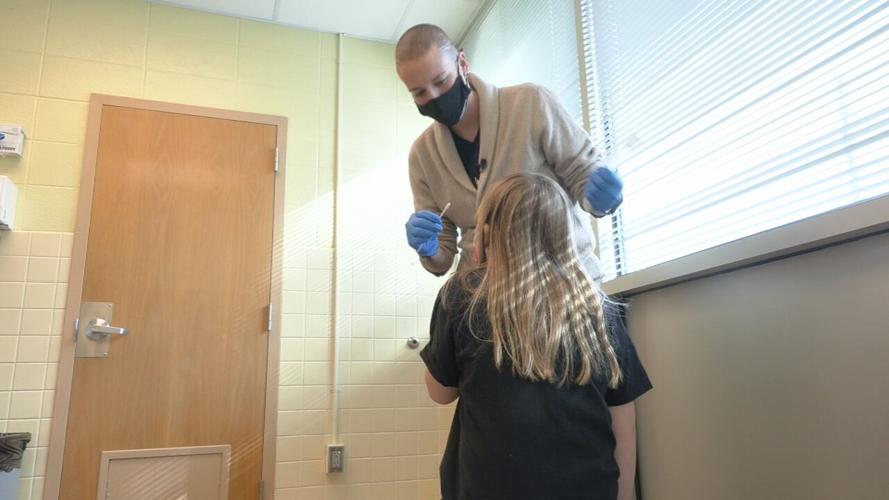LOUISVILLE, Ky. (WDRB) – Testing and contact tracing have made work much different for nurses at Jefferson County Public Schools during the COVID-19 pandemic.
For two school nurses interviewed by WDRB News on Thursday, the added pandemic-related responsibilities combined with their regular job duties like administering medicines and treating students with various ailments have them regularly working estimated 80-hour work weeks.
On top of their responsibilities at their schools, both help with contact tracing after hours for schools throughout JCPS.
But they say the extra workload is worth keeping students healthy and in classrooms during a public health crisis that has brought unprecedented challenges in modern history.
“In the mornings and in the evenings, I check all JCPS schools,” Christina Bowling, the school nurse at Lincoln Elementary Performing Arts School, said of her work that includes analyzing COVID-19 test results and conducting contact tracing. “All the drive-thru testing, I do all of that, and then during the day I just check with Lincoln … I get up and I stay late to keep kids in the building.”
“Eighty hours would be a good guess for me right now,” Navada Weaver, the nurse at W.E.B. DuBois Academy, said of her workload that often includes contact tracing on weekends. “It used to be more than that.”
The 2021-22 school year is the first since the COVID-19 pandemic prompted school districts throughout Kentucky to transition to remote learning at the behest of Gov. Andy Beshear in March 2020 that JCPS students have been back in classrooms on traditional schedules.
Kentucky’s largest school district kept its classrooms closed for a year before reopening them on hybrid instruction schedules for the closing months of the 2020-21 school year.
When the current school year began, Weaver said the number of COVID-19 cases and potential exposures among students at the DuBois Academy left her feeling “slam dunked.” The school took an all-hands-on-deck approach to handling contact tracing at the beginning of the school year, she said.
“I had maybe six or seven cases a day and still had to do contact tracing, did not have enough hands to do contact tracing,” Weaver said.
“I had to get out there, the assistant principals had to get out there, the principal had to get out there, the secretary had to get out there, the attendance clerk had to get out there, but now it's back to where I have a team of three or four and it's feeling more normal now than it did in the beginning of the school year.”
Both Weaver and Bowling say the district’s “test-to-stay” and “test-to-play” programs have helped limit possible COVID-19 exposures and quarantines among students.
JCPS students who participate in extracurricular activities and sports at their schools must undergo weekly COVID-19 testing as part of the district’s “test-to-play” program, and “test-to-stay” allows students who may have been exposed to someone with COVID-19 to continue in-person learning with daily testing rather than quarantining for up to 10 days.
The district’s “test-to-play” program “has been extremely helpful being that we know ahead of time, instead of finding out after and then having to quarantine entire sports teams,” Bowling said.
“It really has helped out with the teams because back when COVID first started and the beginning of this school year even, we had to shut down teams because of one positive student,” Weaver said.
Families have also shown interest in the district’s “test-to-stay” program as an alternative to quarantining after possible exposures to those who have contracted COVID-19.
Bowling said Lincoln Elementary has had more than 20 positive COVID-19 cases since the program began Oct. 18 and only one close contact opted to quarantine rather than undergo daily testing.
“It has been a lifesaver, especially for parents here at our school that can keep their kids in school,” she said.
However, Weaver says some barriers remain for families who cannot get their children tested daily for COVID-19 before the next day’s classes. She estimates a “50-50 chance” that DuBois Academy families will choose participating in the district’s “test-to-stay” program rather than quarantining their children.
“It depends on if their parent has to work, if they have transportation to allow them to do ‘test-to-stay,’ and if they don't have those things to help them get to the school to do ‘test-to-stay’ after hours, then they'll opt in to take the 10-day quarantine,” Weaver said, noting that students can return to classes after quarantining for seven days with a negative COVID-19 test. “… A lot of times the children won't get the whole 10 days. They will get a break in there if the parents are able to get them tested earlier.”
Student vaccinations have also helped reduce the number of quarantines after possible exposures, they said. Fully vaccinated students do not need to quarantine after they come into close contact with someone who later tested positive for COVID-19.
Elementary students at Lincoln, who are newly eligible for the Pfizer-BioNTech vaccine after it was authorized for use in 5- to 11-year-olds earlier this month, have not had enough time to be fully vaccinated, Bowling said.
Still, vaccinations have helped cut the number of quarantines among older siblings if they have been fully vaccinated against COVID-19, she said.
“If a sibling is positive here and their older sibling in middle school or high school is fully vaccinated, we don't have to do contact tracing for that,” Bowling said.
Weaver says she has seen an uptick in the number of students at the DuBois Academy who have rolled up their sleeves and taken COVID-19 shots. She talks to families about having their children vaccinated “as often as I possibly can,” she said.
“We all as parents want our children in school, so I just I want to encourage parents, please get your children vaccinated,” Weaver said.
Copyright 2021 WDRB Media. All Rights Reserved.

























